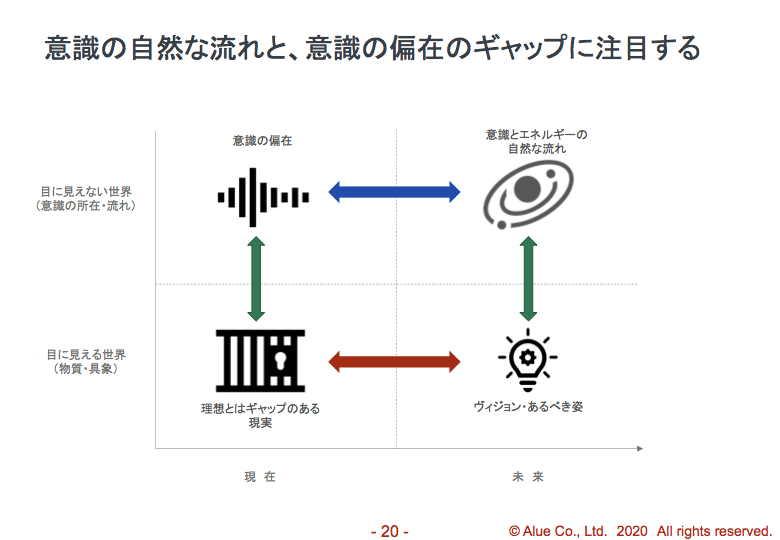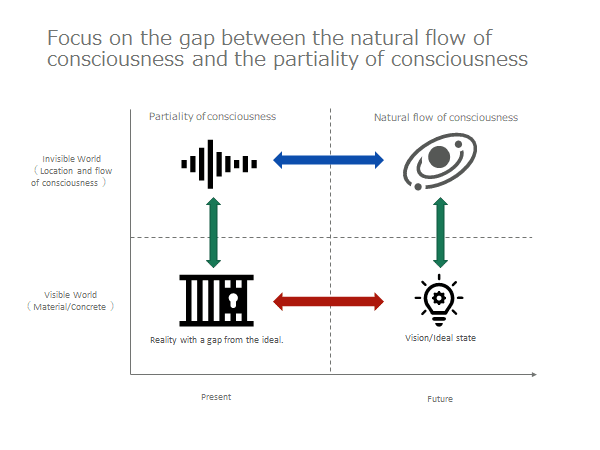
ヴィジョン構想のはじめの一歩は何か?(ヴィジョン構想のプロセス①)
前回の記事では、世の中の流れをどのように捉えるかというテーマで、VUCA時代において現象面での予測は難しくなってきている一方で、意識レベルの流れについて捉えることはできるという話をしました。
世の中の流れをどのように捉えるとよいか
▼両極をもつ軸において意識の重心の移り変わりと捉えること
▼歴史的に見れば螺旋的発展として捉えること
▼その発展は連続的変化だけではなく飛躍的変化として現れる可能性があること
これまでの記事において、いいヴィジョンの要件についてお話しをしてきました。ここでそのポイントをまとめておきます。
いいヴィジョンの要件
▼【主体的真理とのつながり】自分の、そして、チームメンバーの主体的真理とつながっており、内なるエネルギーが引き出されている
▼【野心ではなく志】自分のためだけ(野心)ではなく、自分を含めた周囲の人のため(志)になっている。そして、内なるエネルギーと志が両立している
▼【意識の変容を伴う】現象面の変化だけではなく、意識の変容を含意している
※原因的要件のみを列挙。結果的要件についてはこちらの記事参照
今回の記事では、このような要件を満たすヴィジョンをどのように構想していけばいいのかについてお話しします。
ここでは、ヴィジョンの構想という表現を使っていますが、ヴィジョンを創造する場合であっても、既にあるヴィジョンを再解釈する場合であっても、その本質は変わりません。ご自身の観点から、イメージしやすい方で解釈していただければと思います。
主体的真理から始める
ヴィジョンを構想するにあたって、もっとも大切なことは自分の主体的真理から始めることです。
一般的なアプローチとして、ヴィジョンを構想するためには、世の中の流れを知っておく必要があるということで、政治、経済、社会や技術の動向などを考えていくものがあります。これ自体、意味のあることではありますが、一番始めにやることではないというのが私の考えです。
ヴィジョン構想の初手は、主体的真理につながることです。

いいヴィジョンの要件に、「自分の、そして、チームメンバーの主体的真理とつながっており、内なるエネルギーが引き出されている」というものがありました。主体的真理から始めることが、この要件を満たすことにつながります。
ソニーの設立趣意書に記載されている以下の内容をご存知の方も多いのではないでしょうか。
「真面目なる技術者の技能を、最高度に発揮せしむべき自由闊達にして愉快なる理想工場の建設」
ここに、技術者の方々の技能とエネルギーが最大限発揮されるような工場を創りたいという思い・エネルギーを感じるのは私だけではないでしょう。ソニーの創業者の方々の主体的真理とつながっていることが、このような思い・エネルギーを感じさせる源泉になっていると私は思います。
主体的真理をテーマとした章においても話しましたが、主体的真理は内なるエネルギーの源ですから、その全てが言語化できるものではありません。一定レベルで言語化できていると思える人は、それはそれで素晴らしいことですが、言語化できていなかったとしても全く問題ありません。
主体的真理からくる内なるエネルギーを感じることが大切です。言語化は、内なるエネルギーにつながりやすくなる手段の1つに過ぎません。
どのように主体的真理につながれば良いのかについては、以下の記事を参考にしてください。
私自身の例でいえば、私の主体的真理は次のようなイメージです。
【私自身の主体的真理(を最大限純度高く表現したもの)】
本質追求による大いなるものとの一致感
2003年に起業したときに考えたヴィジョンも、意識の意識化を探求するプロジェクトにおけるヴィジョンも、この主体的真理から始まっています。主体的真理から始めているので、長い時間が経過しても、内なるエネルギーを感じ続けることができています。そして、「石にかじりついてもやり続ける」という意思を持ち続けることができています。
意識の自然な流れと、意識の偏在のギャップに注目する
主体的真理から始めることが初手とするならば、ヴィジョンを構想するための次の手となるものが、「周囲や社会の流れを捉える」ということです。ヴィジョンは、「内なるエネルギーとしての主体的真理」と、「外側のエネルギーとしての周囲や社会の流れ」の重ね合わせになります。

自分の内側と外側の重ね合わせになりますが、あくまでも内側が主体であり、初手であると私は考えています。これを逆にしたり、内側を無視したりすると、そのヴィジョン実現のエネルギーが枯渇してしまいます。
一方で、大きな変革をもたらすヴィジョンを構想するためには、外側のエネルギーとの重ね合わせをすることも大切です。これがないと、こじんまりとしたヴィジョンになってしまいます。大きいからいい、小さいからよくないという話ではありません。ただ、本来の主体的真理からすると大きなヴィジョンを描けるものが、外側のエネルギーの重ね合わせがないがために、こじんまりしてしまうのはもったいないという趣旨です。
さて、「意識の自然な流れと、意識の偏在のギャップ」とは何かについてお話ししましょう。
先ほど、一般的なアプローチとして、ヴィジョンを構想するためには、世の中の流れを知っておく必要があるということで、政治、経済、社会や技術の動向などを考えていくものがあるという話をしましたが、外側の流れを見るという意味では一緒ですが、注目している内容が異なります。

その違いとは、目に見える世界に注目しているか、目に見えない世界に注目しているかの違いです。目に見えない世界というのは、意識の所在や流れを掴むということです。上図において、下半分の物質・具象の世界ではなく、上半分の意識の所在や流れの世界に注目するということです。
なぜ、意識なのか?それは、これまでの記事でもお話ししましたが、現象の根源には意識があるからです。
現象
↓
現象の構造・背景
↓
行動
↓
決断
↓
思考・感情
↓
メンタルモデル(信念体系)
↓
直感(主体的真理)
↓
自己(自意識の主体)
意識の流れがあるから、現象の流れがそれに追随します。換言すれば、意識の流れを掴むことができれば、現象の流れを読むことができます。
意識の自然な流れ・・・周囲や社会や世の中の集合的な意識が、自然と向かっている方向性
意識の偏在・・・上記の意識の自然な流れに反して、何らかの因果、利害関係、組織力学などによって、集合的な意識が偏在していること
そして、意識の流れを掴むというのは、具体的には上記の「意識の自然な流れ」と「意識の偏在」を捉えるということです。
具体的な例でお話ししましょう。今日の学校教育のあり方に問題意識を持っている人は多いと思いますが、それを意識の自然な流れと、意識の偏在という観点から考えて見ると次のようになるでしょう。
(学校教育のあり方の例)
意識の自然な流れ・・・外面に正解があって、その正解を導出する方法を効率的に習得するという教育ではなく、一人ひとりの好奇心やありたい姿を大切にして、周囲や社会と調和しながら生きていく力を涵養するような教育が必要なのではないか
意識の偏在・・・総合的な学習などの取り組みはやっているものの、外面にある正解を導出する方法を効率的に習得するという前提は変わっていない。
これは現在の学校教育の取り組みを否定するものではありません。総合的な学習において、一人ひとりの好奇心を育むような授業をされている学校や先生もいらっしゃいます。しかしながら、その動きや流れはまだ一部であり、上記のような意識の自然な流れと偏在のギャップはまだある状況ではないかと思います。
「意識の自然な流れ」と「意識の偏在」のギャップが大きければ大きいほど、その変革には大きなエネルギーを必要とします。言い方を変えれば、そのギャップが大きければ大きいほど、世の中の常識を転換するようなインパクトがある変革になります。

すなわち、自分たちが構想するヴィジョンが、主体的真理につながっていることを前提とした上で、このような意識の偏在にアプローチするものであれば、それは多くの人の力を結集することができるヴィジョンになる可能性があるということです。
ここで改めて強調させて頂きたいことは、インパクトを求めるあまり、世の中における意識のギャップばかり考えて、主体的真理とのつながりが薄れてはいけないということです。主体的真理とのつながりが薄れてしまうと、自分の内なるエネルギーが枯渇してしまったり、共感・共鳴が得にくくなったりしてしまい、ヴィジョンを掲げても絵に描いた餅になってしまいます。
今回の記事では、ヴィジョンの構想プロセスの冒頭として、主体的真理から始めるということと、意識の自然な流れと意識の偏在とのギャップに注目するということをお話ししました。次回の記事で、ヴィジョンの構想プロセスの続きをお話ししたいと思います。
本日の問いとなります。(よろしければ、コメントにご意見ください)
・ヴィジョンを構想するときに、主体的真理から始めるアプローチと、社会や世の中の動向から考え始めるアプローチを比べて見ると、出現するヴィジョンにどのような質感の違いがありそうでしょうか?
・あなたが感じる、意識の自然な流れと、意識の偏在のギャップには、どのようなものがありますか?
What is the first step in visioning? (Visioning process (1))
In my last article, I talked about how we can understand the flow of the times in the world. In the VUCA era, it is becoming more and more difficult to predict the phenomena, but we can understand the flow at the level of consciousness.
How should we perceive the flow of the times?
▼ To see it as a shift in the center of gravity of consciousness on an axis with two poles.
▼ Historically speaking, it should be seen as a spiral development.
▼ The development is not only a continuous change, but may also appear as a dramatic change.
In the previous articles, I have talked about the requirements for a good vision. I'll summarize those points here.
The Requirements for Good Vision
・Connectedness with the subjective truth: Connectedness with the subjective truth of oneself and team members, drawing out their inner energy.
・Not ambition, but KOKOROZASHI: Not just for oneself (ambition), but for others including oneself (KOKOROZASHI). And inner energy and KOKOROZASHI are compatible.
・Implications of a transformative change in consciousness: This implies not only a change in phenomena, but also a transformative change in consciousness.
In this article, I will talk about how to conceptualize a vision that meets these requirements.
I use the term " conceiving a vision" here, but the essence remains the same whether we are creating a new vision or reinterpreting an existing one. You may interpret it from your own perspective, whichever is easier to imagine.
Start with subjective truth
The most important thing to remember when envisioning a vision is to start with our own subjective truth.
One common approach is to think about political, economic, social, and technological trends, because it is necessary to know what is going on in the world in order to conceptualize a vision. This in itself is meaningful, but in my opinion, it is not the first thing to do.
The first step in visioning is to connect to the subjective truth.
One of the requirements for good visioning is that we are connected to our own and our team members' subjective truths and that our inner energy is drawn out. Starting with the subjective truth will help us to fulfill this requirement.
Many of you may be familiar with the following information from Sony's prospectus.
To establish an ideal factory that stresses a spirit of freedom and open-mindedness, and where engineers with sincere motivation can exercise their technological skills to the highest level.
I am sure I am not the only one who senses the desire and energy to create a factory where the skills and energy of the engineers are maximized. I believe that the connection to the subjective truths of Sony's founders is the source of this desire and energy.
As I mentioned in the chapter on subjective truth, subjective truth is a source of inner energy, and not all of it can be verbalized. If you think you can verbalize it at a certain level, that's great, but it's perfectly okay if you can't.
It is important to feel the inner energy that comes from subjective truth. Verbalization is just one of the ways to become more connected to the inner energy.
For more information on how to connect to subjective truth, please refer to the following article.
In my own example, my subjective truth is the following image.
【My own subjective truth (expressed with the utmost purity)】
A sense of unity with the great through the pursuit of essence
The vision I had when I started my business in 2003, and the vision in my project to explore the ISHIKI(consciousness) management, both started from this subjective truth. Since I started with the subjective truth, I have been able to continue to feel the inner energy even after a long time has passed. And I am able to have the will to keep going at all costs.
Focus on the gap between the natural flow of consciousness and the partiality of consciousness
If starting with the subjective truth is the first step, then the next step in envisioning a vision is to capture the flow of the surroundings and society. Vision is a superposition of "subjective truth as inner energy" and "the flow of surroundings and society as outer energy.”
It is a superposition of the superposition of our inner and outer energies, but I believe that the inner is the primary and first move. If we do this in reverse, or ignore the inside, the energy for the realization of that vision will be depleted.
On the other hand, in order to envision a vision that will bring about great change, it is important to overlay the outer energies. Without this, the vision will be small and compact. It's not that big is good and small is not good. It's just that it's a pity that what could be a big vision from the standpoint of the original subjective truth ends up being too small because there is no overlapping of the outer energy.
Now, let's talk about what the "gap between the natural flow of consciousness and the partiality of consciousness" is.
Earlier, I mentioned that there are some general approaches that consider politics, economics, social and technological trends, etc. In order to conceptualize a vision, it is necessary to know what is going on in the world, but although they are the same in the sense of looking at outward trends, they differ in what we focus on.

The difference is whether we focus on the visible world or the invisible world. The invisible world means to grasp the location and flow of consciousness. In the above diagram, this means paying attention to the upper half of the world, where consciousness is located and flows, rather than the lower half, the material and concrete world.
Why consciousness? It is because, as I have discussed in previous articles, consciousness is at the root of phenomena.
Phenomenon
↓
Structure and background of the phenomenon
↓
Behavior
↓
Decision
↓
Thoughts and feelings
↓
Mental models (Belief systems)
↓
Intuition (Subjective truth)
↓
Self (The subject of self-consciousness)
When there is a flow of consciousness, the flow of phenomena follows it. In other words, if we can grasp the flow of consciousness, we can read the flow of phenomena.
When there is a flow of consciousness, the flow of phenomena follows it. In other words, if we can perceive the flow of consciousness, we can grasp the flow of phenomena.
Natural flow of consciousness: The direction in which the collective consciousness of the surroundings, society and the world is naturally heading.
Partiality of consciousness: The partial distribution of collective consciousness due to some cause and effect, interest, organizational dynamics, etc., contrary to the natural flow of consciousness described above.
And to perceive the stream of consciousness specifically means to perceive the "natural flow of consciousness" and the " partiality of consciousness" as mentioned above.
Let me give you a concrete example. Many people are concerned about the state of schooling today, but if we look at it from the perspective of the natural flow of consciousness and the partiality of consciousness, we can see the following.
(Example of how school education is to be)
Natural flow of consciousness... Rather than an education in which the correct answer is provided from the exterior and the method to derive the correct answer is efficiently learned, we need an education that values the interior curiosity of each individual and the way they want to be, and cultivates the ability to live in harmony with their surroundings and society.
Partiality of Consciousness...The premise of efficiently learning how to derive the correct answer on the exterior has not changed.
This is not to denigrate the current approach to school education. There are some schools and teachers who are conducting classes that nurture the curiosity of each individual in "the Integrated Studies". However, this movement and flow is still partial, and I believe that we are still in a situation where there is a gap between the natural flow of consciousness and the partiality of consciousness as described above.
The larger the gap between the natural flow of consciousness and the partiality of consciousness, the more energy is required to change it. In other words, the larger the gap, the more impactful the change will be, as if it will change the common sense of the world.
In other words, if the vision we envision is based on the premise that it is connected to subjective truth, and if it approaches this partiality of consciousness, it has the potential to become a vision that can unite the power of many people.
What I would like to emphasize again is that we should not be so focused on impact that we only think about the gap in consciousness level and lose our connection to the subjective truth. If we lose our connection to the subjective truth, our inner energy will be depleted and it will be difficult to gain sympathy and resonance, and our visions will become nothing more than painted pictures.
In this article, as the beginning of the visioning process, I talked about starting with the subjective truth and paying attention to the gap between the natural flow of consciousness and the partiality of consciousness. In the next article, I would like to continue the process of envisioning a vision.
Here are the quests of the day. (If you'd like, please share your thoughts in the comments.)
・If we compare the approach of starting from the subjective truth and the approach of starting from the trends of society and the world when conceiving a vision, what kind of differences in texture or quality are likely to emerge in the vision?
・What gaps do you perceive between the natural flow of consciousness and the partiality of consciousness?
Bunshiro Ochiai
この記事が気に入ったらサポートをしてみませんか?
